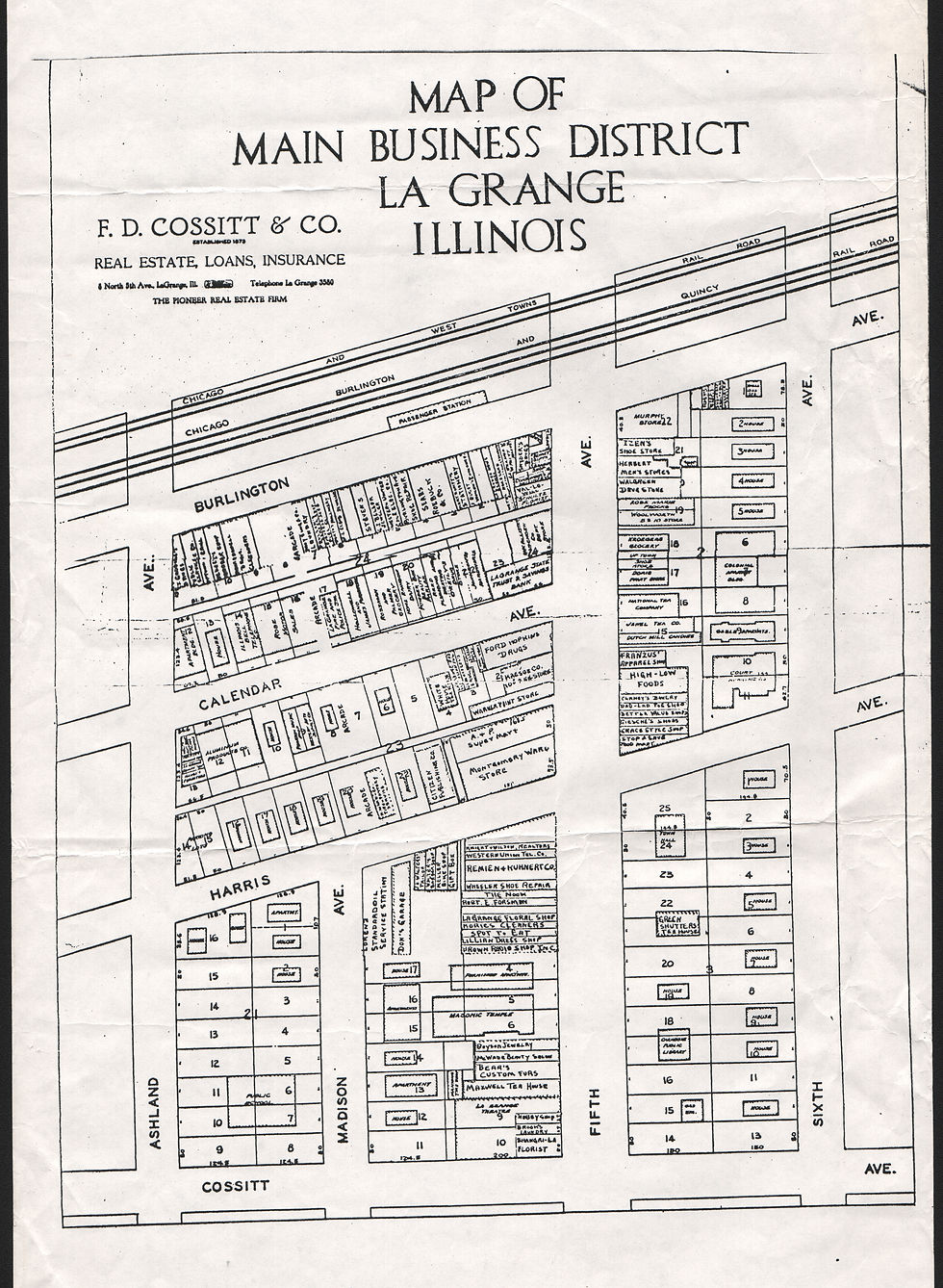
“Village Market is Tomorrow’s Market Today: And it Never Rains in the New Shopping Center.” So stated a headline in the July 6, 1952, Chicago Daily Tribune. What was the Village Market and why does it never rain there? What made it special? The story starts with two real-estate developers, twenty years and 500 miles apart from one another.
Charles Joern, who had begun his career doing real estate development in La Grange Park’s Edgewood section, acquired land east of La Grange Road and north of Ogden Avenue in the 1930s. Following World War II, he set about to develop a whole new community with single-family homes, namely Robin Hood Estates, the Homestead apartments for returning veterans, and a shopping center. Twenty-five years earlier and 500 miles away, J.C. Nichols, in the early 1920s had developed a similar community in Kansas City, clustered around the Country Club Plaza retail center.

Why did La Grange Park need a whole new shopping center when it was only a half mile from La Grange’s already robust retailing district? And what made it “Tomorrow’s Town?”
Automobiles, local population growth, and changing needs of retailers and customers were constraining future growth and prosperity of depot district retail districts such as that of La Grange. Retailers needed larger floor space, more modern appearance, and most important, easy automobile access and abundant off-street parking. The La Grange retail district after World War II consisted of about 100 individual mostly narrow lots with limited on-street parking. That commercial district typified traditional retail districts throughout Chicagoland and the nation.
J.C. Nichols’ revolutionary Country Club Plaza design, opened in 1923, sought to avoid all those constraints. Country Club Plaza is acknowledged to be the first regional shopping center designed specifically for automobile access, visually harmonized with the surrounding environment, and with common management and tenant selection. Similar projects followed in other places. In 1930, the Park and Shop at Cleveland Park on Washington D.C.’s Connecticut Avenue, promoted its automobile friendly site by its very name. Stores were set back from the street with a buffer of off-street automobile parking. Dallas’ Highland Park Shopping Village opened the next year, combining automobile accommodation and pedestrian circulation in an architecturally cohesive atmosphere.
Chicagoland developers, Charles Joern among them, were aware of the shopping center trend and sought to replicate that formula in and around the Windy City. In 1949, Park Forest Plaza retail center opened thirty-five miles south of Chicago, in conjunction with the new Park Forest residential community. By 1951, three new regional shopping centers were being constructed closer to Chicago, namely Evergreen Park Shopping Plaza, Lincoln Village, and La Grange Park Village Market, ushering in a new era of retailing.

With the opening of Robin Hood Estates and Homestead Apartments, Charles Joern’s “Tomorrow’s Town” was taking shape. Construction of the Village Market began in November, 1950. The 10 ½ acre site featured multi-level buildings with space for 43 shops and stores, all air-conditioned, surrounded by off-street parking for 1,049 cars. All pedestrian areas were protected by canopies, so “it never rains” on shoppers.
The first tenant, Charles A. Stevens Company, a long-established women’s fashion retailer on Chicago’s State Street, opened a branch store on February 7, 1952. Stevens was followed by a F.W. Woolworth variety store, Burny Brothers bakery, John A. Colby & Sons furniture store, C.D. Peacock Jewelers, and a National Tea Company grocery store. Woolworth and National Tea had already been established merchants in the legacy La Grange retail district. Though originally conceived as a shopping center to draw customers primarily from a three-mile radius, including La Grange, La Grange Park, Brookfield and Western Springs, the Village Market promptly began drawing shoppers from as far away as Geneva, Aurora and Fox River Grove.

For more than a decade, the Village Market’s success came substantially from enlargement of the catchment area (the geographic range of the customer base), rather than from taking of business from the La Grange legacy retail district. Other competitive forces, however, were at work. The 1962 opening of the Oakbrook Shopping Center, and the 1968 opening of Yorktown Center changed the face of west suburban retailing, attracting previously loyal La Grange area shoppers. Yorktown, at the time of its opening was the fourth largest indoor shopping mall in the nation.

Regional retailing has continued to evolve over the past several decades. Newer malls opened. Free-standing “big box” stores along arterial streets and internet e-commerce have continually changed the competitive retailing environment. 1949’s Park Forest Plaza is completely gone. Evergreen Park Shopping Plaza and Yorktown Center are scaled down and reformatted. Both La Grange Park’s Village Market and the legacy La Grange retail district have continually adapted. None of Village Market’s original tenants are even still in business. Yet both commercial centers and are alive and well.

Comments